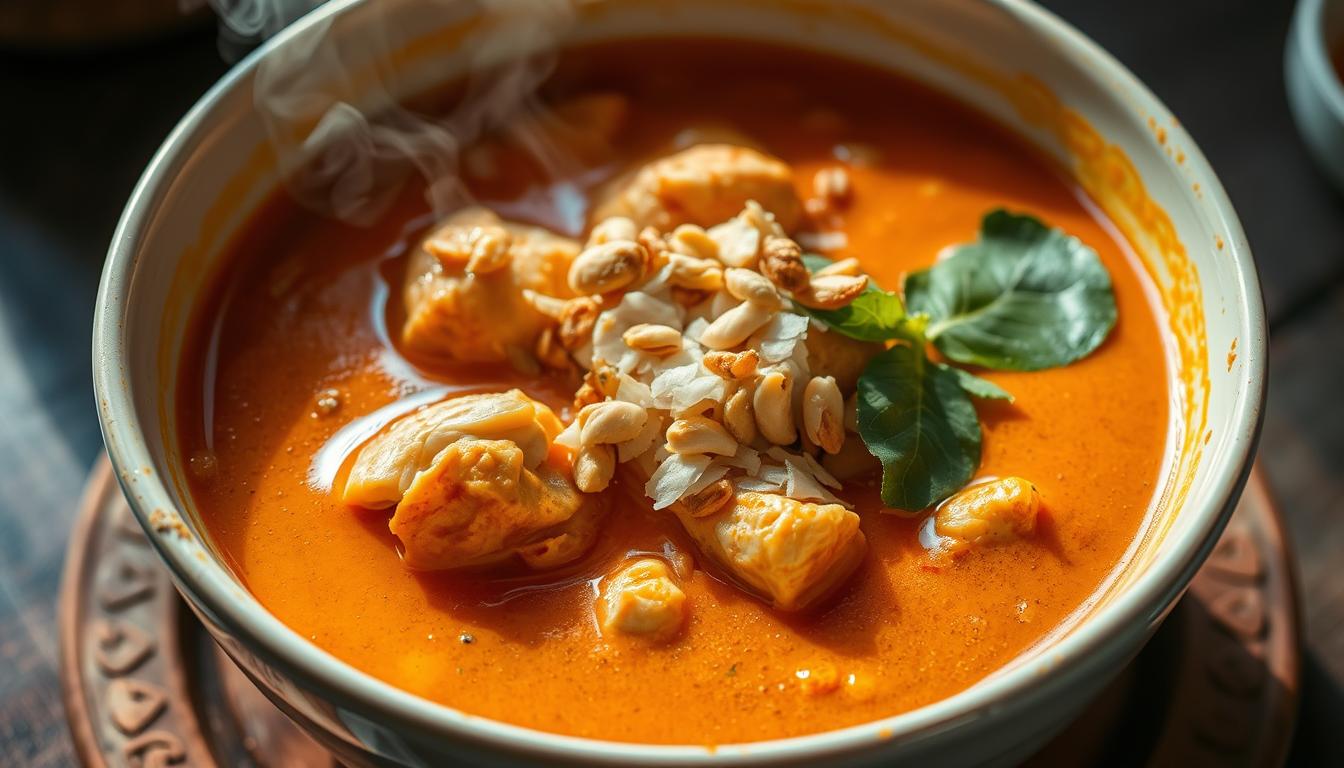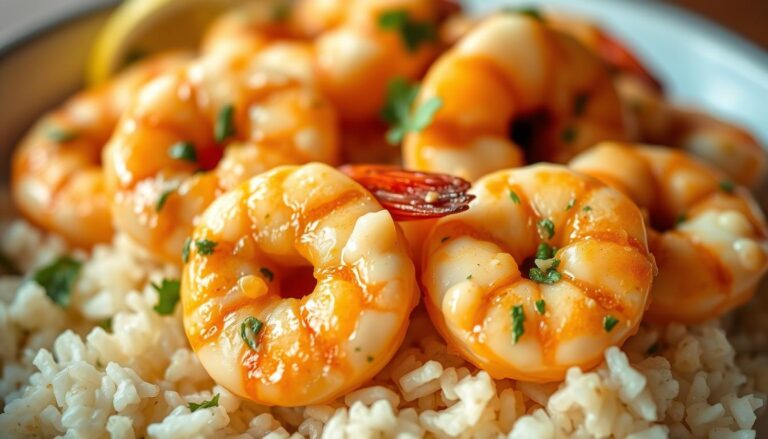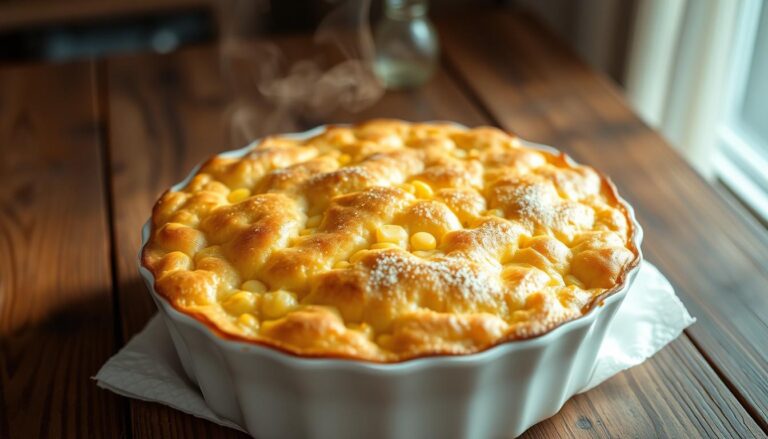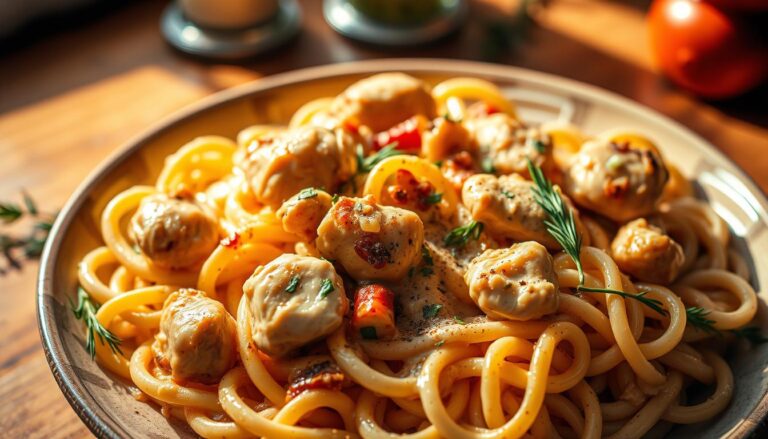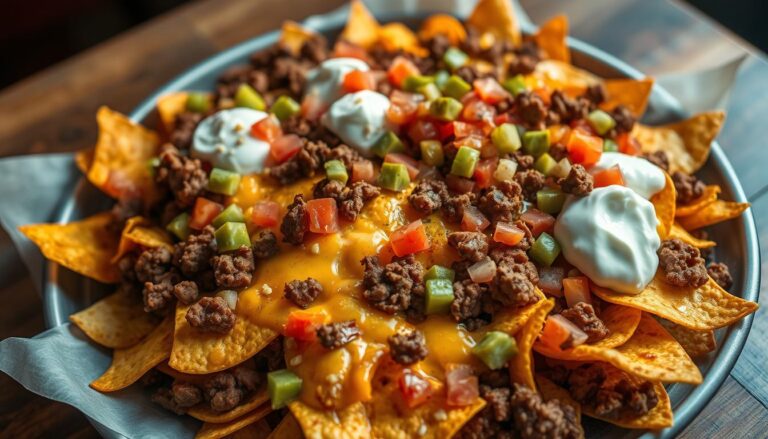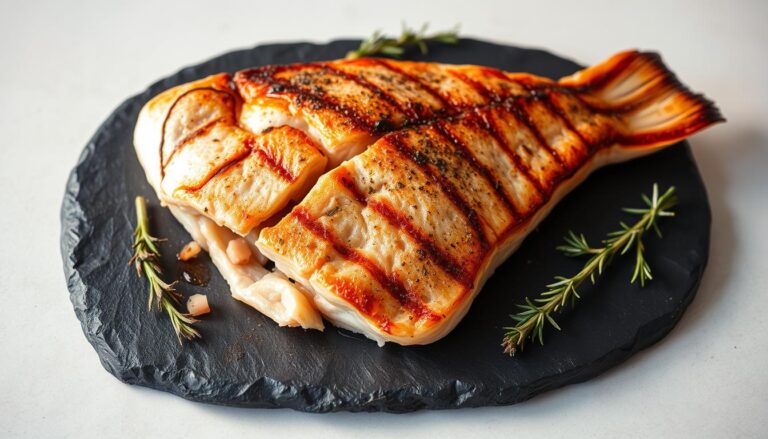Panang Chicken Curry: Creamy, Spicy, and Irresistible
Imagine walking through Thailand’s lively streets, filled with the smells of its famous food. You’re about to start a journey to make the irresistible Panang Chicken Curry. This dish has won the hearts of food fans everywhere.
This classic Thai recipe is famous for its creamy texture and a hint of spice. It’s a favorite in many places. The mix of soft chicken, aromatic Panang curry paste, and coconut milk makes it a true authentic Thai dish.
As you dive into this recipe, you’ll find out what makes it so special. You’ll learn how to make this tasty dish for yourself.
Key Takeaways
- Panang Chicken Curry is a rich and creamy Thai dish.
- It’s made with chicken, Panang curry paste, and coconut milk.
- The curry paste gives the dish its distinctive flavor.
- Coconut milk adds to the creamy texture.
- This recipe is a great representation of authentic Thai cuisine.
What is Panang Chicken Curry?
Panang Chicken Curry comes from Thailand and is loved for its special taste and flexibility. It’s a key part of Thai cuisine, with a rich and slightly sweet flavor. This comes from Panang curry paste and coconut milk.
Origins of Panang Curry
Panang curry, also known as Phanaeng curry, comes from southern Thailand. The name ‘Panang’ might come from the Malaysian word ‘penang,’ a type of curry. It evolved over time, mixing local tastes and ingredients, becoming a big part of Thai culinary traditions.
Key Ingredients Used
The flavor of Panang Chicken Curry comes from its main ingredients. Panang curry paste, made from spices, herbs, and sometimes peanuts, is the base. When mixed with coconut milk, it becomes creamy and aromatic. Chicken, spices, and herbs add to the dish, making it hearty and fulfilling.
The coconut milk adds richness and balances the spiciness of the Panang curry paste. This mix, with tender chicken, makes Panang Chicken Curry a favorite in Thai cuisine.
Why You’ll Love Panang Chicken Curry
Panang Chicken Curry is a hit because of its perfect mix of spices and creamy texture. It’s not just tasty but also easy to make at home.
A Perfect Blend of Flavors
Panang Chicken Curry is known for its rich and complex flavor profile. The curry sauce, made with coconut milk, peanuts, and spices, is creamy and slightly spicy. Here’s what makes it special:
- Aromatic spices like cumin and coriander
- Fresh ingredients such as lemongrass and galangal
- The richness of coconut milk
- A hint of sweetness from palm sugar
Simple to Make at Home
Making Panang Chicken Curry is easy and doesn’t lose any flavor. You can whip up this spicy curry dish with basic steps and ingredients. Here’s how to make it simpler:
- Use pre-made Panang curry paste to save time on spice preparation.
- Choose boneless chicken for quicker cooking.
- Coconut milk adds creaminess without much effort.
Follow these tips to enjoy a delicious and authentic Easy chicken curry at home.
Essential Ingredients for Your Recipe
Panang Chicken Curry is all about the ingredients. You need to pick the right chicken and spices for a great taste. This makes the curry authentic and delicious.
Chicken Choices: What Works Best?
The chicken you choose affects the curry’s flavor and texture. Chicken thighs are better than breasts because they’re tender and juicy. They also have more fat, which helps balance the spiciness.
Use either boneless or bone-in chicken thighs for the best results. Boneless thighs cook faster and are easier to eat. Bone-in thighs add more flavor. Make sure the chicken is fresh and of good quality.
Spices and Herbs to Enhance Taste
The spices and herbs make Panang Chicken Curry special. Key ingredients include Panang curry paste, coconut milk, fish sauce, and kaffir lime leaves. The curry paste gives a deep, sweet, and spicy flavor. Coconut milk adds richness and cools down the heat.
Important spices and herbs include lemongrass, galangal, and Thai basil. Together, they create a complex and aromatic flavor. This is what makes Panang Chicken Curry so unique.
| Ingredient | Purpose | Tips |
|---|---|---|
| Chicken Thighs | Main protein source | Use boneless for convenience or bone-in for extra flavor |
| Panang Curry Paste | Provides core flavor | Choose a high-quality paste for the best flavor |
| Coconut Milk | Adds richness and creaminess | Use full-fat coconut milk for a richer curry |
| Kaffir Lime Leaves | Adds aromatic flavor | Use fresh leaves if possible for the best aroma |
Cooking Techniques for Perfect Curry
To make an authentic Panang curry, you need to know the right cooking methods.
Techniques like sautéing and steaming greatly impact your curry’s taste and texture. It’s important to understand how these methods work to get the perfect flavor and consistency.
Sautéing vs. Steaming
Sautéing means quickly cooking ingredients in a pan with a bit of oil. It’s great for bringing out the rich flavors of Panang curry paste. By sautéing the paste, you unlock its aromatic compounds, making your curry taste better.
Steaming is a gentler way to cook that keeps ingredients tender. But for Panang Chicken Curry, it might not bring out the deep flavors you’re looking for.
Tips for Precise Cooking Times
Getting the cooking time just right is key for an easy chicken curry. If you cook it too long, the chicken gets tough and the curry too thick. Cooking it too short means it won’t be fully flavored.
- Cook the chicken until it reaches an internal temperature of 165°F (74°C) to ensure food safety.
- Simmer the curry for at least 10-15 minutes to allow the flavors to meld together.
- Adjust the cooking time based on the thickness of your curry: thicker curries may require longer cooking times.
By learning these cooking techniques and tips, you can make a delicious and authentic Panang curry that will wow everyone.
How to Make Panang Chicken Curry
Making Panang Chicken Curry is easy and fun. It starts with making the curry paste and then cooking the chicken and coconut milk. This Thai curry recipe is tasty and simple to make at home.
Step-by-Step Instructions
First, prepare the curry paste. You can buy Panang curry sauce or make it from scratch. If making it, blend chilies, garlic, lemongrass, and spices together.
Heat oil in a pan over medium heat. Sauté the curry paste until it smells great. Then, add the chicken and cook until it’s fully coated and cooked through.
Once the chicken is done, add the coconut milk. Let it simmer for a few minutes. This will thicken the sauce and blend the flavors.
- Prepare the curry paste.
- Sauté the curry paste in oil.
- Cook the chicken.
- Add coconut milk and simmer.
Recommended Cooking Tools
Using the right tools makes cooking Panang Chicken Curry easier. Here are some must-haves:
- A blender or food processor for the curry paste.
- A large pan or wok for cooking the chicken and curry sauce.
- A wooden spoon or spatula for stirring.
Follow these steps and use the right tools to make a delicious Panang Chicken Curry. Your homemade Thai curry will impress everyone!
Pairing Suggestions
Panang Chicken Curry tastes better with the right pairings. These enhance its creamy and spicy flavors. Choosing the right sides can make your meal more enjoyable.
Best Rice Options to Serve
The rice you choose can either match or contrast the curry’s rich taste. Here are some top picks:
- Jasmine rice, known for its fragrant aroma and fluffy texture
- Basmati rice, which adds a nutty flavor and separate grains
- White rice, a simple and neutral base that lets the curry shine
| Rice Type | Flavor Profile | Texture |
|---|---|---|
| Jasmine Rice | Fragrant, slightly sweet | Soft, fluffy |
| Basmati Rice | Nutty, aromatic | Separate grains, fluffy |
| White Rice | Neutral | Soft |
Complementary Side Dishes
To balance your Easy chicken curry meal, add side dishes that match its flavors. Here are some ideas:
- Steamed vegetables, such as broccoli or carrots, for a crunchy contrast
- A fresh salad with a light vinaigrette to cut through the richness
- Pickled vegetables or spicy slaw for an added layer of flavor
By choosing the right rice and sides, you can make a complete and satisfying meal. This will highlight the best of Panang Chicken Curry.
Storing and Reheating Tips
You can enjoy your Panang Chicken Curry for days with simple storage and reheating tips. These steps are key to keeping the dish tasty and safe.
How to Store Leftovers Safely
To keep your Panang Chicken Curry fresh, store it in an airtight container in the fridge within two hours of cooking. This stops bacteria from growing and keeps the curry’s taste.
When storing, remember these tips:
- Cool the curry to room temperature before refrigerating to prevent condensation.
- Use shallow containers to help the curry cool faster and more evenly.
- Label the container with the date to keep track of how long it’s been stored.
Best Methods for Reheating
There are several ways to reheat your Authentic Panang curry, each with its own perks.
| Reheating Method | Instructions | Benefits |
|---|---|---|
| Stovetop | Heat over low flame, stirring occasionally. | Allows for even heating and flavor adjustment. |
| Microwave | Cover and heat in 30-second intervals, stirring between each interval. | Quick and convenient. |
| Oven | Cover with foil and heat at 300°F (150°C) for 15-20 minutes. | Maintains moisture and is suitable for large quantities. |
Whichever method you choose, make sure your Spicy curry dish heats up to at least 165°F (74°C) for safety.
Nutritional Information
When you enjoy Panang Chicken Curry, think about its nutritional value. This dish, from Thai cuisine, has a mix of nutrients. These nutrients add to its health benefits.
Caloric Breakdown of Your Dish
A typical serving of Panang Chicken Curry has a good balance of nutrients. The coconut milk curry base adds a lot of calories, mainly from fat. Here’s a quick look:
- Protein: Chicken is the main protein, with about 30-40 grams per serving.
- Fats: Coconut milk brings in around 20-25 grams of fat per serving.
- Carbohydrates: The curry’s carbs come from coconut milk and veggies, about 20-25 grams per serving.
Health Benefits of Key Ingredients
The ingredients in Panang Chicken Curry have many health perks. The Panang curry paste adds flavor and antioxidants. Chicken is lean protein, good for muscles. Coconut milk, though high in saturated fats, has MCTs that might be healthy.
Some key health benefits are:
- Anti-inflammatory effects from the spices in the curry paste.
- Protein from chicken helps with muscle repair and growth.
- MCTs in coconut milk may help with energy and weight management.
Common Mistakes to Avoid
To make a delicious Panang Chicken Curry, avoid common errors. Knowing these mistakes helps you make a easy chicken curry that wows everyone.
Missteps in Spice Balance
One big mistake is not balancing the spices right. A good spicy curry dish needs spices that work well together. Too much of one spice can ruin the taste.
Start with a small amount of spices and add more if needed. It’s harder to take out too much spice. Use a table to keep track of spice levels and adjust as you go.
| Spice | Initial Amount | Adjustment |
|---|---|---|
| Cumin | 1 tsp | +0.5 tsp |
| Coriander | 2 tsp | +1 tsp |
| Cayenne Pepper | 0.5 tsp | +0.25 tsp |
Overcooking the Chicken
Don’t overcook the chicken, or it will be tough and dry. Cook it until it’s almost done, then take it off the heat. The chicken will finish cooking a bit from the heat left in the pan.
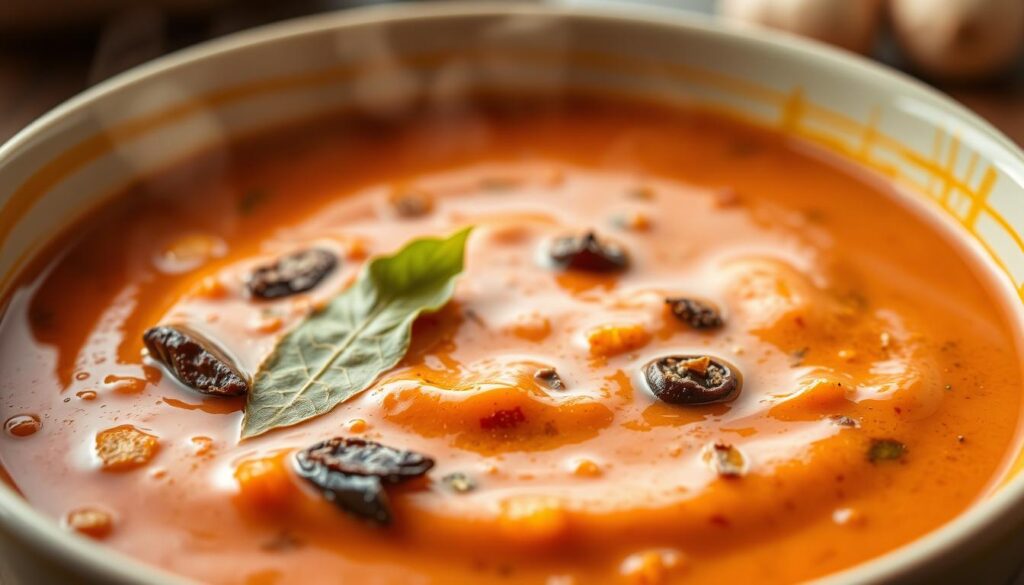
When making Panang curry sauce, simmer it gently. This prevents the coconut cream from breaking, which can make the sauce unpleasant. Stir the sauce often and check its consistency to get it just right.
- Use boneless, skinless chicken breast or thighs for the best results.
- Cook the chicken until it reaches an internal temperature of 165°F (74°C).
- Let the chicken rest for a few minutes before serving to allow the juices to redistribute.
Variations and Customizations
Panang Chicken Curry is very flexible. You can change it to suit your dietary needs or just to try something new.
Vegetarian and Vegan Alternatives
Want a vegetarian or vegan version of Panang Chicken Curry? You can swap the chicken for other proteins. Here are some good options:
- Tofu: A favorite for vegans, tofu soaks up the curry flavors well.
- Tempeh: This fermented soybean product has a nutty taste and a firm texture.
- Seitan: Made from wheat gluten, seitan is a solid meat substitute for curries.
- Mushrooms: Big mushrooms like portobello or shiitake add a meaty feel.
For those who don’t eat meat, you can use tamari or nama shoyu instead of fish sauce. Coconut milk or a non-dairy cream keeps the curry creamy.
Spice Levels: Mild to Extra Hot
Adjusting the spice level is a fun part of making Panang Chicken Curry. For a milder curry, cut down or skip the Thai chilies and chili paste. If you prefer it hotter, add more chilies or sriracha.
| Spice Level | Adjustments |
|---|---|
| Mild | Reduce or omit Thai chilies and chili paste |
| Medium | Use the recipe’s suggested amount of chilies and chili paste |
| Extra Hot | Add more Thai chilies, chili paste, or sriracha |
With these tweaks, you can make Panang Chicken Curry just how you like it. Whether you prefer it mild and creamy or spicy and bold.
Final Thoughts on Panang Chicken Curry
Panang Chicken Curry is a dish that’s both rewarding to make and delicious to eat. It has a rich flavor that’s typical of Thai cuisine. The mix of tender chicken, creamy coconut milk, and spices makes it a must-try.
Why Panang Chicken Curry is Worth Trying
Trying Panang Chicken Curry lets you dive into the world of Thai cooking. Its base of coconut milk adds a creamy and aromatic touch. You can also tweak it to fit your taste, adjusting the spice and ingredients to your liking.
Share Your Panang Chicken Curry Creations
We invite you to make Panang Chicken Curry and share your unique versions. Feel free to play with different ingredients, spice levels, and pairings. By sharing, you can inspire others and find new ideas for your cooking.
Make every evening delicious—check out our complete Dinner Recipes lineup!
FAQ
What is Panang Chicken Curry, and how does it differ from other Thai curries?
Panang Chicken Curry is a creamy, slightly spicy dish from Thailand. It’s made with chicken, Panang curry paste, and coconut milk. Unlike other Thai curries, it has a rich, creamy texture and a special spice blend.
Can I make Panang Chicken Curry without using store-bought curry paste?
Yes, you can make it from scratch. Use chilies, lemongrass, and spices to make your own paste. But, high-quality store-bought paste can make it easier.
What type of chicken is best suited for Panang Chicken Curry?
Boneless, skinless chicken thighs work best. They’re tender and flavorful. Chicken breast can also be used, but thighs are preferred.
How can I adjust the spice level in Panang Chicken Curry to suit my taste?
Adjust the spice by adding more or less paste. You can also add cayenne pepper or red pepper flakes. Dairy or coconut milk can help cool it down.
Is Panang Chicken Curry suitable for vegetarians or vegans?
Yes, it can be made vegetarian or vegan. Just replace chicken with tofu or tempeh. Use vegan-friendly paste and coconut milk too.
What are the best rice options to serve with Panang Chicken Curry?
Jasmine rice is a great choice. It’s fragrant and fluffy. You can also try steamed basmati or coconut rice for a twist.
How should I store leftovers of Panang Chicken Curry?
Cool it down, then put it in an airtight container. Refrigerate or freeze it. Reheat it to a safe temperature to avoid illness.
Can I freeze Panang Chicken Curry, and how does it affect the flavor and texture?
Yes, you can freeze it. Freezing might change the texture a bit. But the flavor stays the same. Reheat it and adjust the seasoning or coconut milk as needed.
What are some common mistakes to avoid when making Panang Chicken Curry?
Avoid overcooking the chicken and using low-quality paste. Also, make sure to balance the flavors. Follow a good recipe and adjust as you go.

